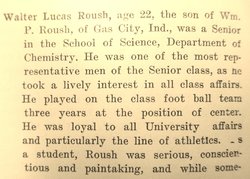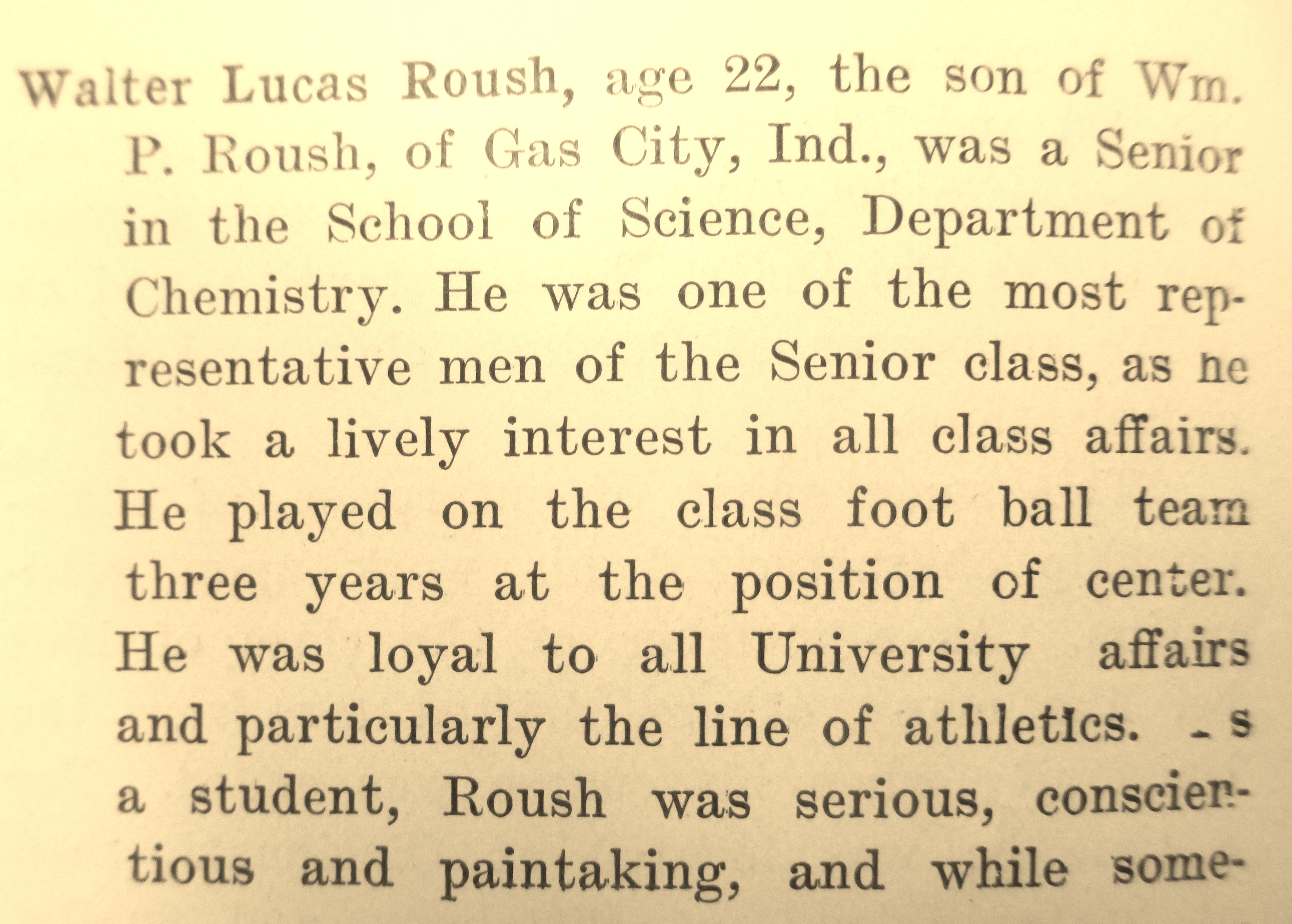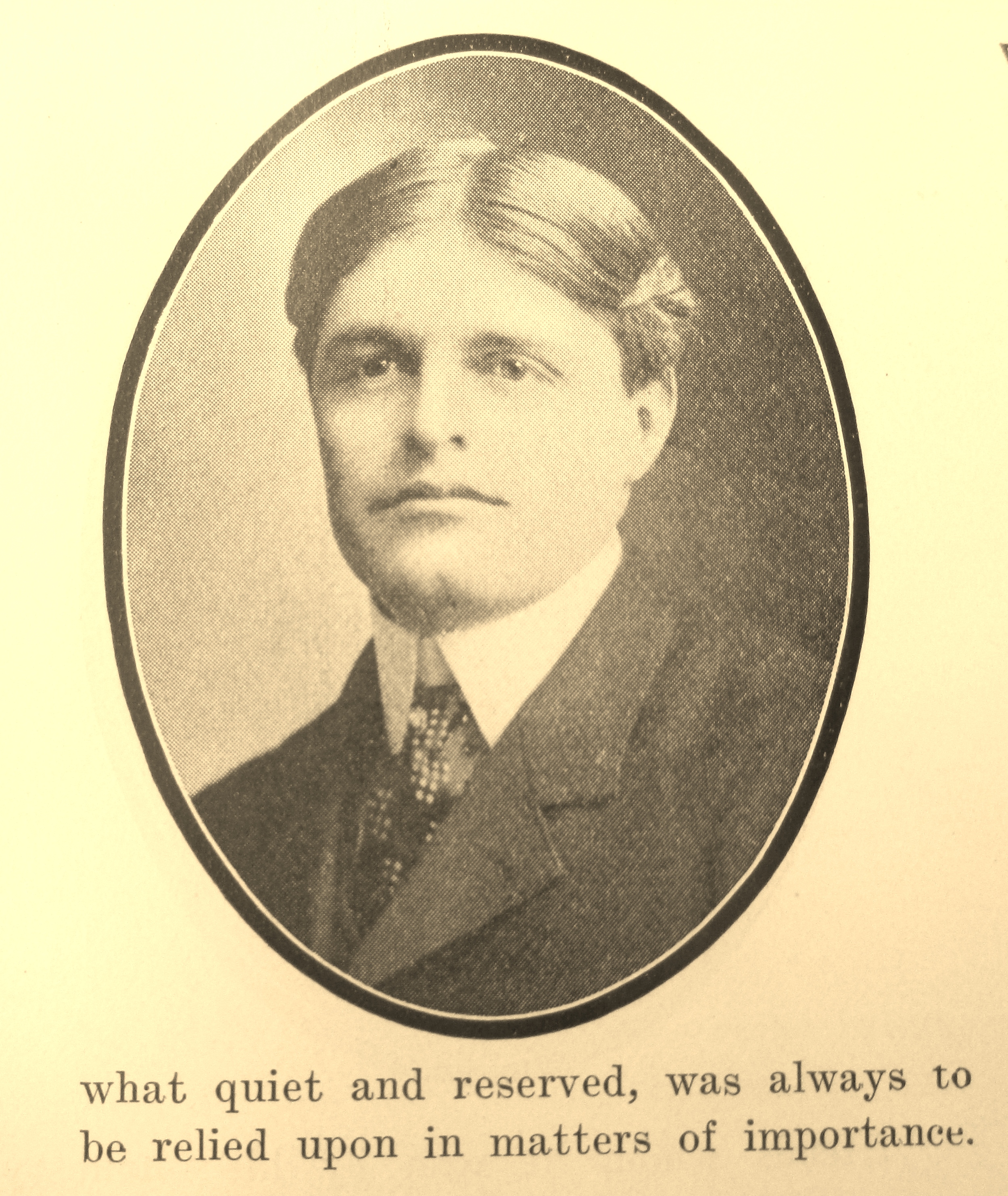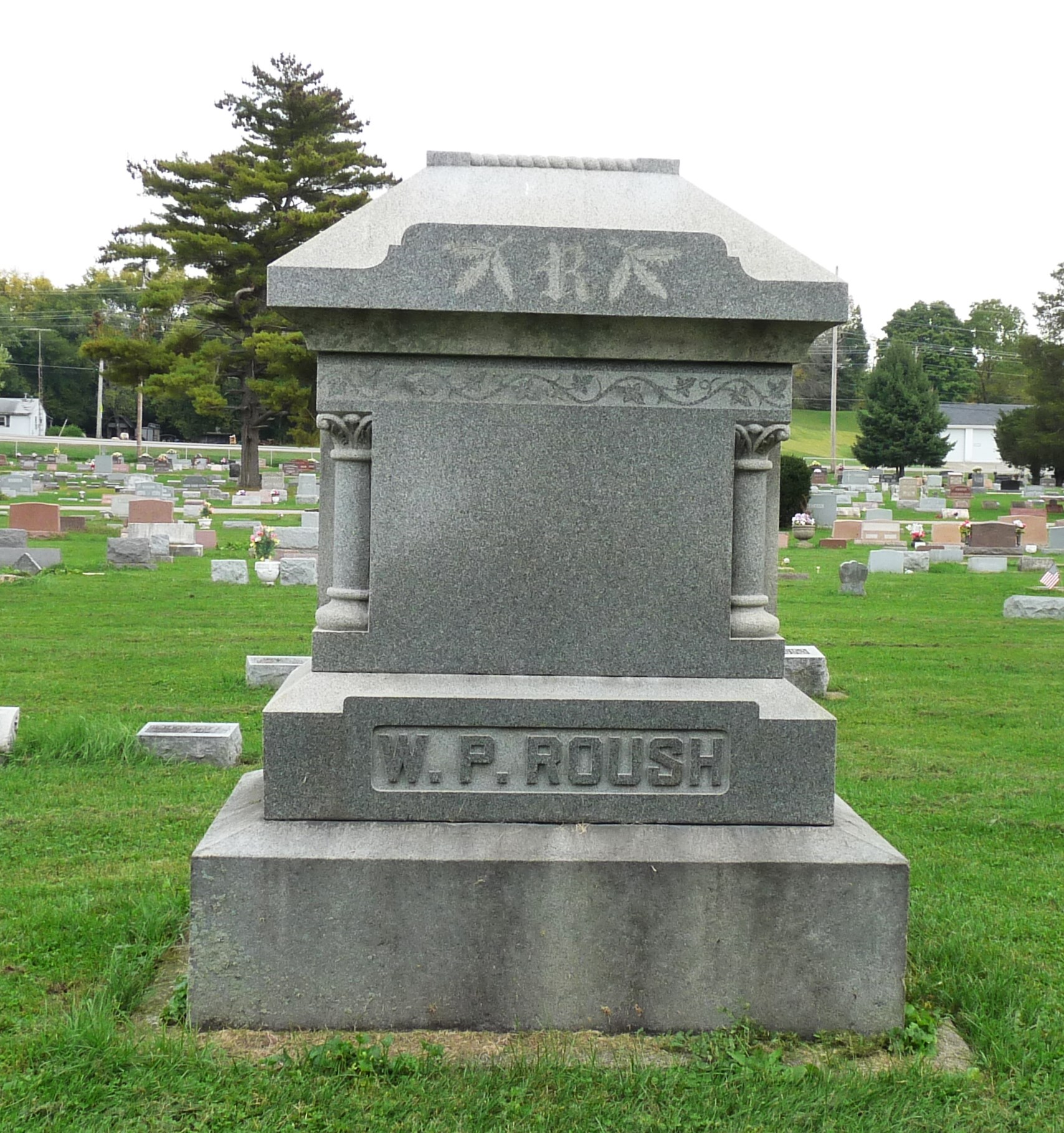Killed in the collision were assistant Coach Edward Robertson,Athletic Trainer Patrick McClaire and players Thomas Bailey, Josesph Coates, Gabriel Drollinger, Charles Furr, charles Crube, Jay Hamilton, Walter Hamilton, Roswell Powell, Wilbert Price,Walter Roush,George Shaw, Samuel Squibb, Samuel Truitt,Also a businessman Newton Howard.
The football rivalry between Purdue and Indiana was just as fierce and partisan back in 1903. That year the annual game held the special novelty of being played at Washington Park just north of downtown Indianapolis. Such was the interest in the game that two trains, each with fourteen cars, operated by the Big Four Railway were chartered to carry over 1,500 people from West Lafayette to Union Station in downtown Indianapolis.
The first car on the first train carried the Purdue football team and their coaches and assistants, followed by a car containing the Purdue marching band along with fans attending the game. In all, there were 954 people in the first two cars.
It was a boisterous, party atmosphere aboard the Purdue Special, which had just entered the city limits of Indianapolis, when a tragic error in communication occurred. A Clerk further up the line had failed to inform the Yardmaster of the approaching Specials and as the Purdue trains sped toward what was then 18th Street at 40 miles-per-hour just as a switch engine hauling several coal cars backed its way onto the main track.
The Engineer of the Purdue Special rounded a bend and saw the coal trains in front of him. He immediately threw the engine into reverse, yanked the emergency brake, and leaped from the train.
The Purdue Special plowed into the coal cars, splintering the first passenger car killing 16 people outright, thirteen of them members of the Purdue football team. A fourteenth player, Walter Bailey of New Richmond, Indiana, died of his injuries the next day.
The second car in the first train plunged down a fifteen-foot embankment. A third car was thrown off the tracks. As survivors, including Purdue President Winthrop E. Stone, tended to the dead and wounded, another group of survivors raced back up the tracks to stop the train behind them. In all, seventeen people died from the wreck and fifty more were injured, some gravely.
"Many of the bodies were so mangled that they could be identified only by letters and other paper in the clothing," it was reported at the time.
It was believed that Harry G. "Skillet" Leslie, a start athlete on both Purdue's football and baseball teams, Captain of the Football Team and Student Body President, had been killed in the wreck. So great was this belief that he was removed to the Indianapolis morgue. It was only as the morticians prepared to embalm his body that they detected a pulse and Harry Leslie was rushed to the hospital.
Harry Leslie's recovery was slow and involved several painful operations that would leave him with a limp and a cane for the rest of his life. He returned to Purdue at the end of 1904 and graduated in 1907 with a degree in Law.
Harry Leslie opened a law office and coached high school football in Lafayette, dabbling in farming and local politics before becoming a bank president, a position he held until 1924 when he left to serve in the Indiana House of Representatives on the Republican ticket. In 1928, he was elected Governor of Indiana, the only Purdue alumni, so far, to hold that office.
After leaving office, Harry Leslie became founder and president of the Standard Insurance Company, headquartered in Indianapolis. He died suddenly of a heart attack on December 10, 1937, at the age of 59 while in Miami, Florida visiting his great friend, Hoosier author and Purdue alumni, George Ade.
You won't read about Harry G. Leslie in Wicked Indianapolis, which rather demonstrates the lack of follow through mentioned earlier, but, on the other hand, I would have never known the first thing about the 1903 Purdue train crash or Harry G. Leslie except for reading Wicked Indianapolis propelling me to dig a little deeper into the subject.
The Purdue Boilermakers didn't try to regroup for the remainder of the 1903 season.
Harry Leslie, who would later lead the Alumni Association at Purdue, and the other surviving students of Purdue University, threw themselves behind a fundraiser effort and in 1909 the Memorial Gymnasium was dedicated with seventeen steps leading to the front entrance commemorating each of the seventeen people who died in the wreck. For many decades after that Memorial Gymnasium was the home to Purdue's intercollegiate athletics and a general gathering place for students who held dances and other activities there. In 2006, Memorial Gymnasium, by then in use as a computer science building, was renamed Felix Hass Hall by the Trustees in honor of Professor Felix Hass for his role in establishing the computer science department at Purdue, which just seems like all kinds of wrong.
In 2003, to mark the centennial of the train wreck, Purdue dedicated the tunnel leading to the home team's locker room at the Ross-Ade Stadium, co-named for George Ade and Trustee David E. Ross who were instrumental in its construction, in West Lafayette.
A tunnel does seem uniquely resonant to honor the victims of a train accident, although no tunnel was involved in the disaster. It somehow seems that wave after wave of enthusiastic young Boilermakers pass hopefully through the limestone arches to return in victory or defeat in a singularly appropriate way to commemorate the worse train wreck in Purdue history to date.
Killed in the collision were assistant Coach Edward Robertson,Athletic Trainer Patrick McClaire and players Thomas Bailey, Josesph Coates, Gabriel Drollinger, Charles Furr, charles Crube, Jay Hamilton, Walter Hamilton, Roswell Powell, Wilbert Price,Walter Roush,George Shaw, Samuel Squibb, Samuel Truitt,Also a businessman Newton Howard.
The football rivalry between Purdue and Indiana was just as fierce and partisan back in 1903. That year the annual game held the special novelty of being played at Washington Park just north of downtown Indianapolis. Such was the interest in the game that two trains, each with fourteen cars, operated by the Big Four Railway were chartered to carry over 1,500 people from West Lafayette to Union Station in downtown Indianapolis.
The first car on the first train carried the Purdue football team and their coaches and assistants, followed by a car containing the Purdue marching band along with fans attending the game. In all, there were 954 people in the first two cars.
It was a boisterous, party atmosphere aboard the Purdue Special, which had just entered the city limits of Indianapolis, when a tragic error in communication occurred. A Clerk further up the line had failed to inform the Yardmaster of the approaching Specials and as the Purdue trains sped toward what was then 18th Street at 40 miles-per-hour just as a switch engine hauling several coal cars backed its way onto the main track.
The Engineer of the Purdue Special rounded a bend and saw the coal trains in front of him. He immediately threw the engine into reverse, yanked the emergency brake, and leaped from the train.
The Purdue Special plowed into the coal cars, splintering the first passenger car killing 16 people outright, thirteen of them members of the Purdue football team. A fourteenth player, Walter Bailey of New Richmond, Indiana, died of his injuries the next day.
The second car in the first train plunged down a fifteen-foot embankment. A third car was thrown off the tracks. As survivors, including Purdue President Winthrop E. Stone, tended to the dead and wounded, another group of survivors raced back up the tracks to stop the train behind them. In all, seventeen people died from the wreck and fifty more were injured, some gravely.
"Many of the bodies were so mangled that they could be identified only by letters and other paper in the clothing," it was reported at the time.
It was believed that Harry G. "Skillet" Leslie, a start athlete on both Purdue's football and baseball teams, Captain of the Football Team and Student Body President, had been killed in the wreck. So great was this belief that he was removed to the Indianapolis morgue. It was only as the morticians prepared to embalm his body that they detected a pulse and Harry Leslie was rushed to the hospital.
Harry Leslie's recovery was slow and involved several painful operations that would leave him with a limp and a cane for the rest of his life. He returned to Purdue at the end of 1904 and graduated in 1907 with a degree in Law.
Harry Leslie opened a law office and coached high school football in Lafayette, dabbling in farming and local politics before becoming a bank president, a position he held until 1924 when he left to serve in the Indiana House of Representatives on the Republican ticket. In 1928, he was elected Governor of Indiana, the only Purdue alumni, so far, to hold that office.
After leaving office, Harry Leslie became founder and president of the Standard Insurance Company, headquartered in Indianapolis. He died suddenly of a heart attack on December 10, 1937, at the age of 59 while in Miami, Florida visiting his great friend, Hoosier author and Purdue alumni, George Ade.
You won't read about Harry G. Leslie in Wicked Indianapolis, which rather demonstrates the lack of follow through mentioned earlier, but, on the other hand, I would have never known the first thing about the 1903 Purdue train crash or Harry G. Leslie except for reading Wicked Indianapolis propelling me to dig a little deeper into the subject.
The Purdue Boilermakers didn't try to regroup for the remainder of the 1903 season.
Harry Leslie, who would later lead the Alumni Association at Purdue, and the other surviving students of Purdue University, threw themselves behind a fundraiser effort and in 1909 the Memorial Gymnasium was dedicated with seventeen steps leading to the front entrance commemorating each of the seventeen people who died in the wreck. For many decades after that Memorial Gymnasium was the home to Purdue's intercollegiate athletics and a general gathering place for students who held dances and other activities there. In 2006, Memorial Gymnasium, by then in use as a computer science building, was renamed Felix Hass Hall by the Trustees in honor of Professor Felix Hass for his role in establishing the computer science department at Purdue, which just seems like all kinds of wrong.
In 2003, to mark the centennial of the train wreck, Purdue dedicated the tunnel leading to the home team's locker room at the Ross-Ade Stadium, co-named for George Ade and Trustee David E. Ross who were instrumental in its construction, in West Lafayette.
A tunnel does seem uniquely resonant to honor the victims of a train accident, although no tunnel was involved in the disaster. It somehow seems that wave after wave of enthusiastic young Boilermakers pass hopefully through the limestone arches to return in victory or defeat in a singularly appropriate way to commemorate the worse train wreck in Purdue history to date.
Gravesite Details
S/O William P & Anna M
Family Members
Sponsored by Ancestry
Advertisement
Explore more
Sponsored by Ancestry
Advertisement









